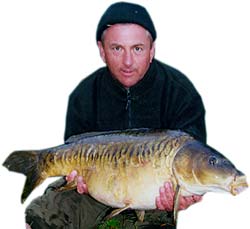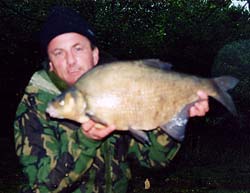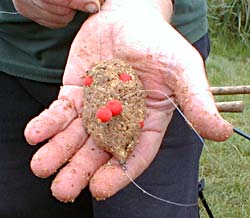| PART 2 – CATCHING ‘EM! Having spotted bream and got to know something about the area they are in the next consideration is to get them to pay a visit to a table lovingly prepared by you!
Lay them a nice table Questions still need to be asked though. For instance, is the water heavily carp fished? Do the bream have to rely mainly on natural baits? What is the bream population? What is the other species population? What is the make up of the other species? The answers to questions such as these can help you to decide whether to go in with mini carp tactics or to try to emulate a natural feeding zone, or as is more usual a mixture of both. And you will obviously need some idea of how much bait to introduce into the swim. A shoal of 30/50 big bream will not be held long by a gallon of maggots and a shoal of 100 would see you needing a trawler for a bait boat! And if the tench have got to them first there won’t be any left anyway! If money were absolutely no problem I would, without a doubt, choose maggots for all my bream fishing (most other fishing too!) but on some waters with a large population of fish it would take a good week’s wages to fish for more than three days! So usually I have to make up with other goodies. That’s not to say that I don’t rate naturals or ‘specials’ like boilies, paste, or even good old fashioned baits like bread and corn, they all have their part to play and response to bait can vary from water to water, but I have yet to come across any water that doesn’t respond to a maggot approach. The only problem is if those carp (or as my fellow bream basher Gary ‘Barney’ Knowles tongue-in-cheek calls them ‘ratfish’ – at least I think it’s tongue in cheek!) move in, they don’t half respond to bream tactics……the buggers!
I usually add live maggots when I’m actually baiting up, the dead ones last longer if kept in a little water so don’t mix them otherwise the live ones will do a disappearing act! I tend to keep my deads with the hemp and wheat and rice (all soaked and boiled!). I also use dry baits like pellets and live maggots, but in separate containers until I’m ready to bait up. The dry baits and wet baits can then all be put into a mixing bowl and either spodded, or boated out. Don’t ignore boilies It would be very unwise to ignore the boilie as a bream bait for there are waters where they relish them and they are resistant to the attentions of small fish right from the off. My own personal favourites are fishmeal based – bream love fishmeal! And of course the favourite of a lot of bream anglers, Richworth Esterberry. A very useful bream boilie can be made with trout pellet powder (I’m never happy the actual pellet is still on if it’s a long wait). Mix the trout pellet powder with a little decent boilie base mix or even semolina to make it easier to roll and add this to eggs and flavours in the usual way. It does catch and when you are being hammered by eel and silverfish at night the boilie can help you to keep your sanity!
Deliver the bait accurately to a marker Having decided the areas to bait the next thing is to deliver the bait accurately to the swim, bearing in mind you also have to put the hookbait in with the same accuracy. The best way on big pits is that dinghy again; I can then keep it as tight as I like if each rod is fishing a different swim or create a pattern of feed that gives me a chance of picking up bream passing at different distances from the bank. For instance, a bed of bait laid down at an angle from the first rod so that by the time it reaches the third rod it is fishing further out. You can work out a multitude of ways to lay the table, it all depends on the make-up of your swim, the aim being to maximise the chance of picking up the passing shoal and then holding it long enough to hopefully catch a couple. Swim markers are used to mark the feature that is going to be baited, that way the swim can be very accurately topped up and the baited rig dropped in with the same accuracy. The best type is probably a single length of 15mm white plastic piping which can be weighted at the base and hinged, then the mainline won’t get tangled in it when a fish takes, the line will just slide over the pipe as it bends over. A piece of flexible tube is pushed and taped in to the base of the pipe to make the hinge, the other end of the flexi-tube is secure in concrete. The ‘underwater’ part of the pipe can be painted to make it less noticeable.
THE method, ignore it at your peril! It has been some while since I have bream fished a water where I could introduce the bait by hand or even catapult but they are both options to bear in mind. Bream aren’t always 100yds from the bank. It pays to keep an open mind, especially if others are failing with distance methods. Which brings me onto another method. THE method, a fantastic addition to the bream man’s repertoire – ignore it at your peril! The tench love it too, as my last failed bream trip but very successful tench trip will confirm! Tackle and rigs for catching bream are a pretty standard affair. Location is the important bit! My own gear consists of three 12ft, 1 When you purchase through links on our site, we may earn an affiliate commission, which supports our community.
|
Welcome!Log into your account














